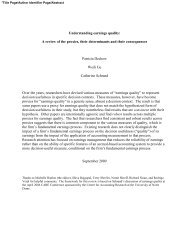Nike Considered: Getting Traction on Sustainability - MIT Sloan ...
Nike Considered: Getting Traction on Sustainability - MIT Sloan ...
Nike Considered: Getting Traction on Sustainability - MIT Sloan ...
You also want an ePaper? Increase the reach of your titles
YUMPU automatically turns print PDFs into web optimized ePapers that Google loves.
NIKE CONSIDERED: GETTING TRACTION ON SUSTAINABILITY<br />
Rebecca Henders<strong>on</strong>, Richard M. Locke, Christopher Lyddy, Cate Reavis<br />
The <str<strong>on</strong>g>C<strong>on</strong>sidered</str<strong>on</strong>g> Group<br />
In late 2005, Parker, J<strong>on</strong>es and John Hoke, then VP of Footwear Design, formed the <str<strong>on</strong>g>C<strong>on</strong>sidered</str<strong>on</strong>g><br />
Group as a way to diffuse the <str<strong>on</strong>g>C<strong>on</strong>sidered</str<strong>on</strong>g> ethos of high-performing, aesthetically pleasing greener<br />
products. Its mandate was to provide the inspirati<strong>on</strong> and tools to drive the <str<strong>on</strong>g>C<strong>on</strong>sidered</str<strong>on</strong>g> design<br />
philosophy deep into <str<strong>on</strong>g>Nike</str<strong>on</strong>g>’s product creati<strong>on</strong> units 19 and processes. The group’s objectives included<br />
helping <str<strong>on</strong>g>Nike</str<strong>on</strong>g> c<strong>on</strong>sider the impacts of choices <strong>on</strong> the entire product lifecycle from design through end<br />
of life, and understand and reduce its envir<strong>on</strong>mental footprint. 20 Instead of commanding and<br />
c<strong>on</strong>trolling the ways in which the businesses implemented sustainability, the group placed<br />
resp<strong>on</strong>sibility for sustainability in the hands of designers who birthed the product. 21<br />
The <str<strong>on</strong>g>C<strong>on</strong>sidered</str<strong>on</strong>g> Group was at <strong>on</strong>e and the same time a think tank, tool box, internal c<strong>on</strong>sultancy,<br />
competitive catalyst, the innovati<strong>on</strong> end of sustainability, and an antenna to the outside world. Its<br />
missi<strong>on</strong> was to serve as the hub of the <str<strong>on</strong>g>C<strong>on</strong>sidered</str<strong>on</strong>g> design ethos. The hub’s spokes were product<br />
creati<strong>on</strong> units, to which <str<strong>on</strong>g>C<strong>on</strong>sidered</str<strong>on</strong>g> disseminated knowledge, tools, and user support. It was<br />
organized to remain close to its business c<strong>on</strong>stituents, and had a staff of 14 people with envir<strong>on</strong>mental<br />
and product creati<strong>on</strong> expertise, dedicated to footprint analysis, sustainability innovati<strong>on</strong>, and tools<br />
development. <str<strong>on</strong>g>C<strong>on</strong>sidered</str<strong>on</strong>g>’s General Manager Lorrie Vogel explained the organizing philosophy: “If<br />
you d<strong>on</strong>’t know how to translate envir<strong>on</strong>mental knowledge into products and processes, you’ll always<br />
be outside of the product creati<strong>on</strong> engine.”<br />
The <str<strong>on</strong>g>Nike</str<strong>on</strong>g> Product Engine<br />
<str<strong>on</strong>g>Nike</str<strong>on</strong>g>’s product creati<strong>on</strong> process was handled by teams known as “triads” comprised of a marketer,<br />
resp<strong>on</strong>sible for translating c<strong>on</strong>sumer demands into product specificati<strong>on</strong>s detailed <strong>on</strong> “product briefs,”<br />
a designer, who created the product’s general c<strong>on</strong>cept and layout, and a developer, charged with the<br />
product’s technical details and coordinating producti<strong>on</strong> with the factory. While achieving <str<strong>on</strong>g>Nike</str<strong>on</strong>g>’s<br />
performance standards and hitting margin targets were the most important goals, a shoe’s physical<br />
characteristics, aesthetics and manufacturability were also c<strong>on</strong>sidered key metrics. At any <strong>on</strong>e time,<br />
product teams worked <strong>on</strong> four product seas<strong>on</strong>s with 8-12 products a seas<strong>on</strong>. Product designs and<br />
producti<strong>on</strong> processes needed to pass through three successive design review gates <strong>on</strong> a rigid timeline<br />
that paced the entire <str<strong>on</strong>g>Nike</str<strong>on</strong>g> value chain, making failure to meet deadlines highly problematic.<br />
The shoe producti<strong>on</strong> process at <str<strong>on</strong>g>Nike</str<strong>on</strong>g> (depicted in Exhibit 1), which required the collaborati<strong>on</strong> of triad<br />
developers, liais<strong>on</strong> factory staff, and factory engineers, entailed three steps: cutting out and stitching<br />
upper materials comp<strong>on</strong>ents, molding and shaping soles with “tooling,” and b<strong>on</strong>ding the comp<strong>on</strong>ents<br />
together. (Tooling is a general term for metal producti<strong>on</strong> molds used to create soles.) Upper<br />
comp<strong>on</strong>ents were die-cut from large sheets of materials in patterns created by factory engineers based<br />
19 “Innovate for a Better World: <str<strong>on</strong>g>Nike</str<strong>on</strong>g> FY05-06 Corporate Resp<strong>on</strong>sibility Report,” <str<strong>on</strong>g>Nike</str<strong>on</strong>g>, Inc., May 2007.<br />
20<br />
Ibid.<br />
21<br />
Ibid.<br />
January 21, 2009 6
















